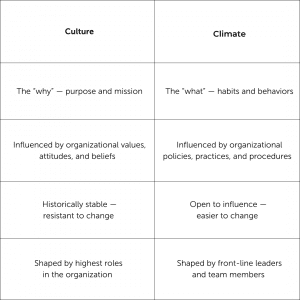With burnout persisting, many organizations are making culture commitments to help employees achieve a more sustainable balance between time on and off the job. But often, these commitments aren’t resulting in the change employees want. That’s because everyday behaviors that contribute to burnout (or its prevention) happen at the organizational climate level.
Although people use the terms organizational culture and organizational climate interchangeably, it’s important to know the difference because each has unique considerations when it comes to influencing behavior. Organizations need both — they’re related — and what matters more than the words we use is alignment within and between culture and climate. Misalignment confuses employees and muddles behavioral expectations.
Consider the following as a simple breakdown for thinking about culture versus climate:

With this distinction in mind, let’s turn to the example of Jan, who was excited to start work at Organization X. She was attracted to the company because its policies explicitly supported employee well-being, such as a flexible work schedule and 20 hours a year of time off allotted for volunteering. After being introduced at her first all-staff meeting, Jan heard several praises of her new team members for going above and beyond, specifically for quick responses after hours and during a long weekend. An “extra big” shout-out went to a team member that took time during her vacation to wrap up a big project.
Jan left feeling uncertain, and rightly so. She’s confused about what behaviors are expected from her because there’s a misalignment between the culture of touting work-life balance and the climate, in which her team members are publicly recognized for working after hours. As a result of this incoherence, her focus is blurred, and she’s unable to concentrate on her work, which negatively impacts her performance and mental health.
The reason organizational climate often differs from culture is that social norms are strong. Because of our desire to avoid social judgment and identify with a group, social norms powerfully influence our decision-making and behavior, causing us to work long hours to receive group praise, for example.
The reality is, organizational climates emerge from behaviors that employees see being recognized, rewarded, and supported. So organizations need to be clear about what they value and how those values show up in daily behaviors. Knowing alignment is needed to accomplish transformation is one thing, but how can organizations bring their current state closer to their ideal? Systematically collect and review information to diagnose the alignment problem.
At NLI, we use an organizational change model centered on priorities, habits, and systems (PHS) to get information from multiple vantage points. Collecting information this way leads to a comprehensive, more realistic picture that’s then underpinned by strategies to reach an ideal state of change. The PHS model supports change at scale because employees understand why the desired change is prioritized, the expected habits that align with the change, and the systems that reinforce and support the new habits. When priorities, habits, and systems align, then the alignment between and within organizational culture and climate is stronger.
Knowing the importance of aligning a company’s culture and climate, imagine if Jan’s manager called for a huddle after the meeting and said, “I’m proud of you all for the work you do. You work so hard, but at the same time, working after hours and during vacation are behaviors that don’t align with valuing well-being, and they put you on a trajectory for burnout. How can I help you rebalance?” And then, when rebalancing is highlighted as a win in the next all-staff meeting, imagine how that would shape employees’ opinions about “how things are around here.”






